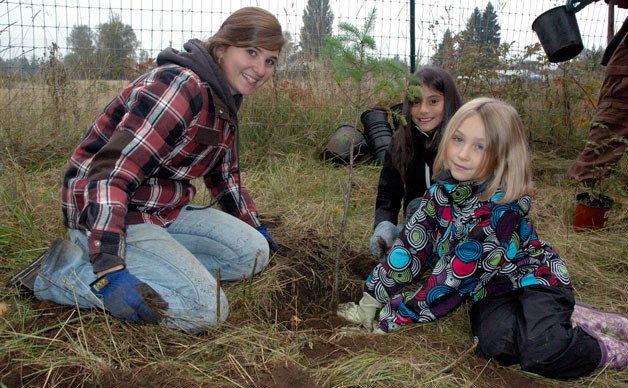MARYSVILLE — The Allen Creek area adjacent to the Bethlehem Lutheran Church in Marysville received yet another ecological enhancement on Wednesday, Oct. 16, as roughly 100 third-grade students from Kellogg Marsh Elementary, just across the street, were joined by more than two dozen third- and fourth-graders from Marshall Elementary, as well as nearly 20 National Honor Society students from Grace Academy, in planting 360 trees at the site.
Roger Kelly, of the Snohomish Conservation District, explained that his agency has partnered with the Adopt-A-Stream Foundation and Snohomish County Public Works Surface Water Management in restoring the site over the years, with volunteer contributions including the 10 yards of mulch that they received from the city of Marysville that day, as well as labor and supplies from members of the Bethlehem Lutheran Church, who have promised to make the site open to the public for environmental education and awareness.
“Kellogg Marsh is so close that they could send their science classes over here,” Kelley said.
“By taking a hands-on approach, rather than just filling out worksheets, our kids are able to learn about these issues by making a difference,” said Melissa Brown, a third-grade teacher at Kellogg Marsh Elementary. “They’ll be able to see the impact of their work, right next to the school.”
“They’re very focused on this,” agreed fellow Kellogg Marsh third-grade teacher Michelle Barnett. “I see their enthusiasm. They’re really taking pride in this.”
Kellogg Marsh third-graders Jessica Dhillon, Chase Marciniak and Cody Mauk were more than happy to explain their process and reasons for planting trees at the Allen Creek site that day.
“When there’s grass and the soil is hard, it’s harder to get the dirt up,” Mauk said, as all three students dug a hole for one of their trees.
“Digging the roots out is the hardest part,” Marciniak said. “I have to jump on my shovel, and then just rip them out.”
“When you put the plant in the ground, you have to pat the soil down gently around it,” said Dhillon, as she gingerly pulled the tree upright, while Marciniak stepped lightly on the filled-in soil around it. “You also have to hold it straight up while you’re putting the soil back in the hole. That’s so the tree doesn’t just fall over when the heavy winds come.”
When asked about the benefits of planting trees, Marciniak noted that they supply us with oxygen, while Dhillon referred more specifically to the intended ecological enhancement at the Allen Creek site by crediting trees with helping to improve water quality, for humans and wildlife alike. Mauk simply saw the day’s planting as a means of “saving nature.”
“It’s great that we’ve got so many volunteers and so much community involvement here,” said Walter Rung, one of the ecologists from the Adopt-A-Stream Foundation who supervised the students’ efforts. “It’s also not raining today, which is nice,” he laughed.
“Marysville is a great city,” said Joe Zak, a sophomore Honor Society student at Grace Academy who also helped the third-and fourth-graders get their trees planted. “I’ve done tree-plantings before, including when I was living in Japan. The first time I did it, I was in the third grade too. I like helping the community. This is a great opportunity to make my hometown greener and cleaner.”
Monte Marti, district manager for the Snohomish Conservation District, was echoed by John Natterstad, a member of the Bethlehem Lutheran Church, in anticipating that the children of today would be able to return to this site, as the parents and grandparents of tomorrow, to point to the tall trees to come and tell the children of the future, “I planted those.”
“Snohomish County is looking at huge urban and population growth within the next 10, 20 and 50 years,” Monti said. “We need to take steps to preserve our natural resources now. If we establish a riparian buffer around this stream, it’ll have less impact and will improve the habitat for salmon. It also gives these kids a sense of ownership.”
“These kids will remember their experiences here, and the purpose behind them,” Natterstad said. “It’ll make their lessons back in the classroom that much more meaningful. Plus, everyone loves to go fishing, so this helps make sure we’ll catch more salmon,” he laughed.
Natterstad explained that the Allen Creek site had been left to the Bethlehem Lutheran Church by the families who had owned the property.
“We want to keep it in its natural state,” said Natterstad, who recalled how stream restoration efforts had actually begun about a decade ago, but had been delayed by funding grants falling through in the meantime. He added that the installation of an Eagle Scout kiosk at the main gate serves its mission of environmental education, by showing visitors what sorts of salmon and vegetation they can expect to see.
Thanks to support from the Washington State Department of Ecology, Adopt-A-Stream has been providing landowners next to Allen Creek with ecological checkups for their stretches of the creek, as well as prescriptions for corrective action when problems are discovered.
Last year, Adopt-A-Stream discovered that the riparian zone next to the Bethlehem Lutheran Church had been eaten by horses grazing next to the stream. With the assistance of the Snohomish Conservation District, Adopt-A-Stream and volunteers from the church installed a 900-foot-long fence to keep horses between 50-100 feet away from the creek, and began to plant new stream-side vegetation over four acres. March 23 of this year saw them complete the planned restoration of the first two acres.
“The more plants we have, the more it benefits both the fish and the stream,” Rung said. “These waters empty out into Ebey Slough, the Qwuloolt Estuary and Puget Sound as a whole. Especially as the tide gates are removed, we expect to see a lot more salmon in this area within the next 10 years.”



